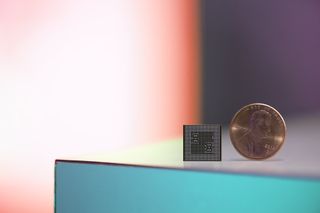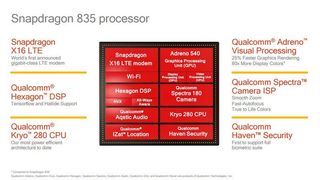Snapdragon 835 debuts with Kryo 280 CPU, Bluetooth 5, Gigabit LTE, and much more

Qualcomm offered up a quick look at the Snapdragon 835 back in November, announcing that it would be the company's first SoC to be built on a 10nm node. At CES, we're getting a detailed look at what's on offer with this year's high-end SoC.
The shift to 10nm means that the overall size of the Snapdragon 835 is 30% smaller than that of the Snapdragon 820, and the node shift brings improvements in energy efficiency to the tune of 40%. Qualcomm is also touting a performance increase of 27% over the previous generation. The smaller design allows handset vendors to build phones with larger batteries or devices with thinner profiles.

In other words, it's a big deal.
We'll go into detail on each aspect of the SoC, but in broad strokes, here's what's new with the Snapdragon 835: eight Kryo 280 CPU cores, Adreno 540 GPU, Daydream support, gigabit LTE modem, multi-gigabit Wi-Fi, Bluetooth 5, Hexagon 682 DSP, Spectra 180 ISP, support for HDR10 video, Quick Charge 4.0, and Qualcomm's Aqstic codec with 32-bit/384kHz support and aptX/aptX HD Bluetooth audio.

The Snapdragon 835 features an octa-core semi-custom CPU design, with four brand-new Kryo 280 performance cores clocked at 2.45GHz and four energy-efficient cores at 1.9GHz. The SoC will rely on the energy-efficient cluster for over 80% of the time, with the 2.45GHz cores activated for intensive use cases like VR gaming. The SoC is also compatible with LPDDR4X memory.
On the GPU side, the Snapdragon 835 comes with the Adreno 540 with support for OpenGL ES 3.2, OpenCL 2.0, Vulkan, and DirectX 12. The latter is interesting as the Snapdragon 835 is the first SoC to power the initial batch of Windows 10 devices powered by ARM.

Battery life is one of the tentpole features of the Snapdragon 835, with Qualcomm claiming at least a day's worth of talk time, over 5 days of music playback, more than seven hours of 4K video streaming, and over three hours of 4K video capture. To put things into context, the Snapdragon 835 consumes half as much power as the Snapdragon 801.
The Snapdragon 835 is also the first SoC to offer Quick Charge 4.0. QC 4.0 supports USB-C and USB-PD (Power Delivery), and boasts 20% faster charging and up to 30% higher efficiency when compared to QC 3.0.
Get the top Black Friday deals right in your inbox: Sign up now!
Receive the hottest deals and product recommendations alongside the biggest tech news from the Android Central team straight to your inbox!
Battery life is one of the tentpole features of the Snapdragon 835, with more than seven hours of 4K video streaming.
In the imaging department, the Spectra 180 is a 14-bit dual ISP that supports up to 32MP cameras or dual 16MP cameras. It offers hybrid autofocus, HDR video recording, optical zoom, hardware-accelerated face detection, better video stabilization, and Qualcomm's Clear Sight tech for devices with dual cameras. The ISP supports H.264 (AVC) and H.265 (HEVC), as well as 4K video capture at 30fps, and 4K playback at 60fps.
With virtual reality gaining momentum, the Snapdragon 835 offers low-latency (15ms motion-to-photon latency) and six-degrees-of-freedom for precise motion tracking. The Adreno 540 GPU displays 60X more colors and is 25% faster at 3D rendering than last year's Adreno 530, leading to more immersive visuals. There's also support for scene-based and object-based audio, HDR10 video, 10-bit color, and the SoC is fully compatible with Daydream.

On the connectivity side of things, there's the Snapdragon X16 LTE modem, which enables Category 16 LTE download speeds that go up to one gigabit per second. For uploads, there's a Category 13 modem that lets you upload at 150MB/sec. For Wi-Fi, Qualcomm is offering an integrated 2x2 802.11ac Wave-2 solution along with an 802.11ad multi-gigabit Wi-Fi module that tops out at 4.6Gb/sec. The 835 will consume up to 60% less power while on Wi-Fi.
The Snapdragon 835 will offer Bluetooth 5, with the SoC being the first commercial product to be certified for the new standard.
The Bluetooth 5 spec was finalized last month, with the standard set to offer double the bandwidth, four times the range, and eight times the message capacity of Bluetooth 4.2. The Snapdragon 835 will offer Bluetooth 5, with the SoC being the first commercial product to be certified for the new standard.

The Snapdragon 835 also runs Qualcomm's hardware-based Haven security platform, which has a secure execution environment for user authentication and device attestation. Another interesting addition is a neural software framework that now features Google's TensorFlow library, enabling manufacturers that rely on machine learning to build better experiences when it comes to photography, security, personal assistants, and virtual reality.
Overall, the Snapdragon 835 marks a significant upgrade for Qualcomm. The SoC is slated to make its way into devices in the first half of 2017!

Harish Jonnalagadda is Android Central's Senior Editor of Asia. In his current role, he oversees the site's coverage of Chinese phone brands, networking products, and AV gear. He has been testing phones for over a decade, and has extensive experience in mobile hardware and the global semiconductor industry. Contact him on Twitter at @chunkynerd.